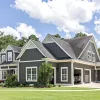New Construction Home Buying Guide: Timeline, Costs & What to Expect

Although new construction homes require more dollars, due diligence, and patience, they come with priceless perks – including not having to worry about fixes or improvements when you take possession. Take the time to carefully research builder candidates, lots and locations, home types and floor plans, lenders, and loan options before committing to a new build.
Eager to purchase a brand-new residence from the ground up? Buying a new construction home certainly has its advantages, including the ability to move into a virtually flawless property with no repair or maintenance worries. But it’s important to understand the process of buying a new build house and what to expect.
Exactly what are the steps to buying a house built new?

Preparing to Buy a New Construction Home
Well before you start shopping for builders, locations, and home types, there are three main areas of consideration when prepping to purchase new construction. For many buyers, this early planning stage is also the right time to decide whether using a real estate agent for new construction could offer added protection and guidance.
Budgeting
Think of budgeting as your roadmap for a newly built property. New construction homes typically cost 10% to 20% more than resale homes nowadays. So you’ll need to crunch your financials carefully and create a realistic budget based on what you can afford.
“But don’t just focus on the sticker price. Factor in closing costs, which typically represent 2% to 5% of your loan, lot premiums, and extras like landscaping or HOA fees,” advises Steven Glick, director of mortgage sales for HomeAbroad. “A tight budget can leave you stuck if costs creep up – especially with upgrades. That’s why I recommend a 10% to 15% contingency fund to cover any surprises.”
It’s also worth understanding how conventional construction loans structure costs, since they work differently than a standard mortgage.
Getting Preapproved for a Mortgage
To ensure your financing will be in order, take it a step further beyond getting prequalified for a mortgage loan. Instead, get preapproved before going any further.
A preapproval will give you a better idea of how much you may be able to borrow and what you can afford. Keep in mind that new homebuilders may provide incentives if you use their in-house lender. But don’t stop there: Take the time to shop around among several different lenders and compare offers and rates.
Understanding Loan Types
Traditional mortgages – including conventional loans backed by Freddie Mac and Fannie Mae, FHA loans, VA loans, and USDA loans –are ideal for spec homes (residences already built or near completion). But you may need a construction-to-permanent loan if you opt for a custom or semi-custom build. These loans cover land and building costs with interest-only payments during construction (typically up to 18 months), then convert into a standard mortgage.
“A construction-to-permanent loan will save you from needing two separate closings, but they often require a 20% down payment and could come with slightly higher interest rates,” says Glick.
Researching Builders, Choosing Location & Picking Construction Type
The next phase of your journey involves finding the right builder and picking your location.
“Keep in mind that not all builders are equal. You’ll need to research their past projects, online reviews, and Better Business Bureau ratings. Also, talk to current homeowners they have built for,” suggests Lori Alvarez, a Realtor in La Verne, California.

Keep in mind that not all builders are equal. You’ll need to research their past projects, online reviews, and Better Business Bureau ratings. Also, talk to current homeowners they have built for.
A reputable builder should deliver a quality product and stay on schedule, while a disreputable builder can produce shoddy work or cause delays. Do avoid the latter, check to see that the builder is properly licensed, funded, insured, and well-rated online.
In addition, vet the area carefully before committing to a particular neighborhood or address. Research crime rates, school system grades and ratings, local community services, area job prospects, and other factors.
“Make sure that the schools and safety of the area are up to the standards you are looking for,” says Ralph DiBugnara with Home Qualified.
In some circumstances, such as if you are buying in a new subdivision or builder development, you may want to choose your location first and then select a builder.
Additionally, you’ll need to decide what type of new construction home you want. Your choices are:
Fully custom home: One-of-a-kind residence with a unique floor plan built to your exact specifications. Often, buyers will hire an architect to design a custom plan. A fully custom home is usually the most expensive option but affords the most control.
Semi-custom home: Usually constructed from a builder’s set plan but which can be altered or tweaked to your liking. Semi-custom homes are commonly less expensive in exchange for less personalization.
Spec home: A newly completed or soon-to-be completed residence that likely cannot be personalized to your tastes but which can be more affordable and quicker to move into.
Understanding the Construction Timeline
Once you commit to a builder, location, and home type, the construction phase begins (unless you are choosing a spec home). Let’s break down three different areas of consideration.
Typical Build Phase
From contract to completion of the home, here are the usual steps involved:
- Site prep – Clear the land and get permits (1-2 months)
- Foundation – Poor concrete, pass inspections (1-2 months)
- Framing – Build the structure (1-3 months)
- Rough-ins – Install plumbing, electrical, HVAC (1-2 months)
- Finishes – Add drywall, flooring, cabinets (2-4 months)
- Final inspections – Ensure code compliance, get occupancy certificate (1 month)
- Closing/move-in – Walk-through, sign papers, get keys (1-2 weeks)
Expected Duration
It often takes six to 12 months from contract to move-in for most new construction homes to be completed. Spec homes can be ready within 4 to 6 months, on average. But fully custom builds could span 12 to 18 months.
“This timeline matters if you are renting or preparing to sell your current home, as delays can mean extra costs like storage or extended rent,” Glick points out. “Common delay culprits include bad weather that pauses work, supply chain shortages of things like lumber or appliances, the complexity of custom designs, and slow approvals of city permits.”

Common delay culprits include bad weather that pauses work, supply chain shortages of things like lumber or appliances, the complexity of custom designs, and slow approvals of city permits.
Navigating Upgrades, Inclusions & Incentives
As with any home for sale, new construction homes will come with standard amenities that are included in the base price, including basic cabinets, appliances, and finishes. But the builder should also offer upgrades for a higher price, such as upgrading from a standard laminate countertop to quartz. Be forewarned: If you tour a model home in a subdivision or development, you may see high-end finishes showcased that don’t necessarily reflect the base price. That’s why it’s important to ask the builder for a list of standard inclusions versus upgrades and prices for the latter.
“Think of buying new construction like shopping for the base model of a car. The builder will try to entice you with upgrades to bring the price up,” says DiBugnara. “Make sure that any upgrades you choose will actually increase the value of your home and not just add items that won’t help on resale. For example, improved landscaping, higher-end bathrooms, kitchen upgrades, and extra living space are all items that could help deliver a higher resale in the future.”
Note that new construction homes also often come with hidden costs you want to ask your chosen builder about, including:
Lot premiums – Expect to pay $5,000 to $20,000 for better lots
Landscaping upgrades – $2,000 to $10,000, which is often not included
HOA fees – Some homeowners associations charge $100 to $500 per month
Change orders – Making changes in the middle of construction can be costly.
Additionally, be aware that some builders often include incentives such as free upgrades, closing cost credits, and/or mortgage rate buydowns.
“Builders may negotiate on closing cost assistance and minor upgrades, but rarely on price,” cautions Joseph Keshi, Realtor and CEO of My Property Managed.
Inspections, Walkthroughs & Final Steps
Even new construction homes can have defects. That’s why the experts strongly recommend enlisting an independent professional home inspector during certain stages of the build.
“I’ve seen new construction homes with wiring issues, plumbing leaks, and code violations. Paying around $300 to $600 for an independent inspection can catch these issues before you close,” Glick says. “The builder might suggest using their own inspector, but they’re not always impartial. Try to hire an International Code Council (ICC)-certified inspector or structural engineer to check at key stages – like foundation, framing, and final walk-through.”
Once construction is completed, it’s time for that final walk-through. At this phase, you’ll want to carefully check and test key systems like HVAC, plumbing, and electrical; ensure that your chosen finishes and upgrades match what’s on your contract; look closely for cosmetic flaws such as paint issues and scratches; and ensure that the property is clean and move-in ready.
“During the walk-through, bring your contract along, as well as a checklist and camera. If you see something is off, negotiate repairs or credits before heading to closing,” recommends Glick. “Expect a builder representative to accompany you on the walk-through – but don’t let anyone rush you. Take your time.”
Managing Delays & Financial Contingencies
As mentioned earlier, your new construction dreams can hit a few snags – such as inclement weather, labor shortages, and backordered materials – that cause delays and cost overruns. That’s why it’s smart to build in an extra cushion of time within your expected timeline as well as a budget buffer just in case cost overruns occur, especially if this is a fully custom home.
“I advise my clients to set aside a 15% to 20% cash cushion and have flexible housing arrangements set up until they move in,” says Keshi.
Once your home is finished, don’t be surprised if the property is assessed at a higher rate, resulting in higher property taxes than you anticipated.
“Property taxes on new homes often rise sharply once the home is reassessed at full value. Buyers should expect escrow adjustments in year one and confirm local tax rates before closing,” suggests Alvarez.
Key Milestones
From start to finish, here are the major milestones involved with purchasing a new construction home:
- Budget appropriately.
- Get preapproved for a mortgage loan and choose a lender and loan type.
- Pick a builder, location, and home type.
- Understand the construction timeline involved.
- Sign the contract: Lock in the price, timeline, and features/upgrades.
- Prepare the site for construction and get approval/permits.
- Construct the home: Foundation, framing, rough-ins, finishes.
- Have the home professionally inspected and conduct a final walk-through.
- Close on the home: Sign documents, pay closing costs, and get the keys.
- Move-in: Usually within two weeks after closing.
FAQs
Can you negotiate upgrades or incentives with builders?
Yes, you can negotiate upgrades and incentives. Builders are more flexible if you are preapproved for a mortgage and in slower markets. Request closing cost credits, free upgrades, and/or rate buydowns. Focus on upgrades that add resale value, like improved kitchen features. Builders may be less flexible on base price but more willing to sweeten incentives.
What are the most common reasons for delays in new construction home timelines?
The most common reasons why new construction homes are delayed include disruptions caused by inclement weather, supply chain shortages or problems, labor shortages and lack of subcontractor availability, permit backlogs, and changes requested by the buyer.
How long does it typically take to build and close on a new construction home?
If it’s a move-in-ready spec home, you can close quickly. If it’s a semi-custom home, expect 6 to 12 months from contract to move-in. If it’s a fully custom build, expect 12 to 18 months. Delays can lengthen this timeline.
What financing options are specific to new construction?
Spec homes are commonly financed using traditional mortgages – including conventional loans backed by Freddie Mac and Fannie Mae, FHA loans, VA loans, and USDA loans. If you choose a custom or semi-custom home, you may need a construction-to-permanent loan, which covers land and building costs with interest-only payments during construction (typically up to 18 months), then converts to a standard mortgage.
The Bottom Line
Although new construction homes require more dollars, due diligence, and patience, they come with priceless perks – including not having to worry about fixes or improvements when you take possession. Take the time to carefully research builder candidates, lots and locations, home types and floor plans, lenders, and loan options before committing to a new build.
“New construction can be incredibly rewarding, but only if you walk in informed,” says Alvarez. “Understanding timelines, hidden costs, and how to negotiate puts you in better control.”






